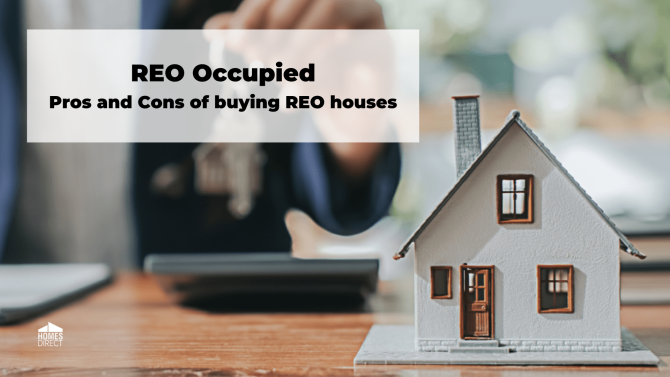If you're a budget-conscious first-time homebuyer or a new real estate investor, you might find REO properties offered at lower prices with similar features.
But what exactly is a Real Estate-Owned property? In this article, we'll explain how properties become REO, explore the pros and cons, and guide you through the process of buying one.

What Is A Real Estate-Owned Property?
In the realm of real estate, a property that has come under the ownership of a lender as a result of a foreclosure is commonly referred to as a real estate-owned (REO) property. Typically, the lender in question is a bank or a government-sponsored entity such as Fannie Mae or Freddie Mac. In instances where a borrower fails to meet their payment obligations, the property becomes subject to foreclosure, leading to the lender regaining ownership.
The lender endeavors to sell the property to the highest bidder through an auction. If no buyers come forward during the auction, the property remains listed as an REO on the lender's records until a suitable buyer is found. While not always representative of the finest properties available in the market, REOs can present intriguing opportunities for investors. Therefore, if you are seeking a favorable deal, it might be worthwhile to explore the prospect of purchasing REOs.
How an REO Property Gains Its Status
Before a home transitions into an REO property, several crucial steps must transpire. Initially, the original homeowner experiences a default on the mortgage, typically triggered by falling several months behind on payments. Consequently, attempts to reach an agreeable solution with the mortgage lender prove futile, leading to options like selling via a short sale or deeding the property back to the lender/investor as an alternative to foreclosure.
Subsequently, the property undergoes the foreclosure process, culminating in a specific date for a foreclosure sale at a predetermined price. Should this sale fail to secure a successful purchaser, management of the property shifts to the lender or investor on the loan, potentially leading to eviction if the property is occupied.
Any properties left unsold after the foreclosure sale are categorized as REO (Real Estate Owned). This designation occurs when the property fails to attract buyers at the specified price, thus transforming it into REO inventory.
It is essential to recognize that both prospective homeowners and investors need to weigh the pros and cons associated with these properties, considering their distinct aspirations and objectives in the real estate market.
Pros Of Buying REO Properties
The advantages of investing in REO properties can be categorized into three key areas, each offering unique benefits. Let's delve into these aspects:
Attractive Affordability
One of the primary drivers of REO sales is their remarkable affordability. During the peak of the housing boom, when people spent more time in their homes, leading to an increased demand for better spaces, REO homes were being sold at an average of $87 per square foot, as reported by a reputable real estate auction site. This figure represented a record high in the market.
Comparatively, the median price per square foot for a home in the U.S. was $123, according to a 2019 report from Realtor.com. Since then, prices have risen considerably in many regions of the country. Despite this surge, REO properties continue to present themselves as alluring bargains, making them an attractive option for budget-conscious buyers.
Tax Benefits
When considering REO properties, one noteworthy advantage is the absence of outstanding taxes. Before making a purchase, conducting a thorough title search and evaluating the lender's guarantees are prudent steps. Opting to buy a property foreclosed on by a lender tends to be more advantageous compared to properties that were previously subjected to tax foreclosure. In the latter case, the new property owner may inherit an unexpected and burdensome tax bill, making it a less desirable proposition.
Favorable Negotiation Opportunities
Given that banks, mortgage lenders, and other mortgage investors do not specialize in property management, they are often motivated to sell and dispose of the acquired properties swiftly. This inclination to expedite the process presents an opportunity for buyers to negotiate on the property's price, offering some flexibility that may not be as readily available in traditional sales.
Cons Of Buying REO Properties
Although REO properties have many benefits, you should keep in mind that they have drawbacks too. We have included a few for you to consider when buying an REO property:
More Competition
The first drawback that you need to consider is that many property investors understand how beneficial it is to buy an REO property and consider it a good way to make money in real estate. This is why, you need to be ready for some competition. In this case, it's a good idea to work with a real estate agent who can help you formulate an offer that will stand out from your competitors.
Occupancy Considerations
If the REO property was a single-unit primary residence, the lender or their representative would handle the eviction of the previous homeowner. However, for multi-unit or investment properties with tenants, buyers need to approach the situation cautiously. The Protecting Tenants at Foreclosure Act mandates providing tenants with a 90-day notice period. Moreover, in certain cases, buyers might be obligated to honor the terms of existing leases. Depending on the state, tenants may possess additional rights, warranting consultation with a local real estate attorney to navigate the situation appropriately.

Source - Pixabay
How To Buy REO Properties As Real Estate Investment
When considering the purchase of a bank-owned property like an REO-occupied home, it's crucial to weigh the pros and cons of the investment. To maximize the benefits and mitigate potential drawbacks, follow these essential tips:
1. Assess Property Value
Before making any investment, particularly in REO properties, it's vital to obtain an accurate estimation of the property's value. Real estate investors should analyze future price trends to understand the potential appreciation of the occupied property. Researching recent sales of comparable properties in the same market can help determine the value of the REO-occupied property.
2. Study the Neighborhood
Thoroughly examine the condition of other homes in the neighborhood. If there's a significant concentration of REO-occupied properties in the vicinity, it could indicate underlying issues to consider. The neighborhood's condition can significantly impact the investment's value, making a well-maintained area more favorable for positive returns.
3. Estimate Renovation Costs
Since lenders typically sell REO-occupied properties in "as is" condition, potential buyers must estimate the costs of necessary repairs and renovations. In the case of an occupied home, the condition might vary depending on how well the current occupant maintains it or their attitude towards vacating. Realistically assessing the repair costs will prevent unexpected financial burdens in the future.
Frequently asked questions about buying an REO property
Where can I find REO properties?
Finding an REO property is easy. There are several ways to find REO properties. You can look for them on various websites or try straight to lenders themselves. What you should keep in mind is that all the banks have different processes and handle REOs differently.
How do I buy REO properties?
There are different options when it comes to buying REO properties. You can do it with the help of banks or participate in real estate auctions where investors attend and bid on properties.
Are REO properties and foreclosures the same things?
No, REO properties and foreclosures are not the same thing. However, they are related to each other. In short, An REO property is only produced as a result of an unsuccessful foreclosure.
Conclusion
As you can see, buying an REO property has both positive and negative aspects. It can be a complex process that requires much time, effort, and knowledge in order to succeed in it. However, after learning how to carry out the process, you can easily own an REO property in a short period of time.
If you're still confused about the process of buying an REO property, you can turn to professionals in the field and complete the required steps with their help in no time.


